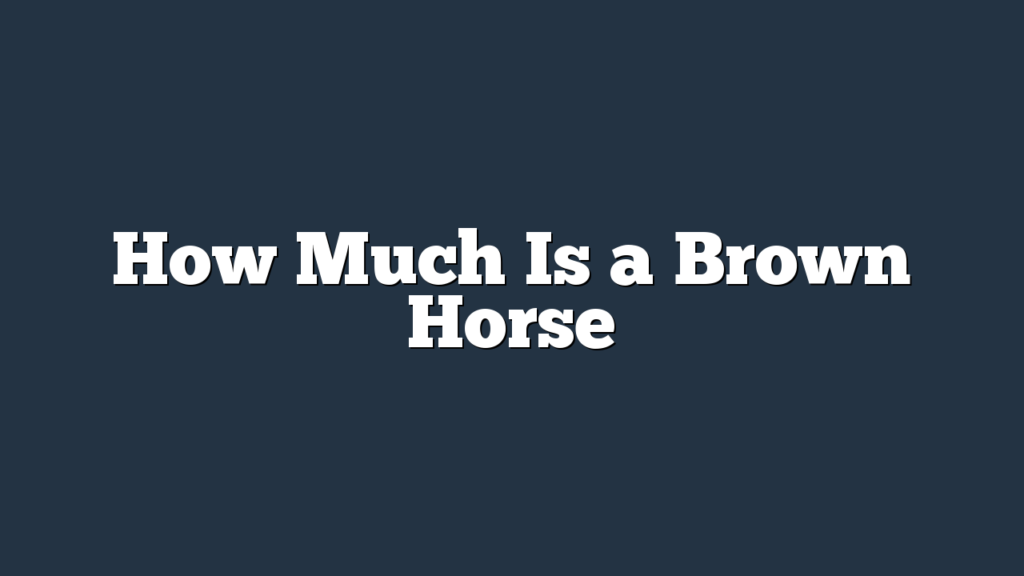Are you curious about the cost of a brown horse? In this article, we will explore various factors that determine the price of these beautiful creatures.
From their breed and bloodline to their age and training level, we will delve into the essentials.
Additionally, we will discuss the importance of health and veterinary records, size and conformation, as well as temperament and behavior.
By considering market demand and location, you’ll gain insight into how much a brown horse may cost.
Breed and Bloodline
When determining the price of a brown horse, it’s important to consider the breed and bloodline that it belongs to. Breed and bloodline play a significant role in determining the value of a horse because they directly impact the horse’s characteristics, abilities, and potential.
Breeding standards are crucial in ensuring that specific traits are passed down from generation to generation. By selectively breeding horses with desirable traits, breeders can establish and maintain certain standards within a particular breed. These standards not only define the breed’s physical appearance but also its temperament and performance capabilities.
Genetic predispositions are another crucial factor to consider when assessing the value of a brown horse. Some breeds may have a genetic predisposition for certain traits, such as strength, speed, or agility. These genetic predispositions can greatly influence the horse’s suitability for specific disciplines or activities.
For example, a horse with a bloodline known for its jumping ability may command a higher price in the showjumping market. Likewise, a horse with a bloodline known for its endurance may be more sought after in endurance riding.
Age and Training Level
To determine the price of a brown horse, consider its age and training level, as they greatly influence its value and potential.
The age of a horse is an important factor to consider when determining its price. Younger horses, between the ages of 1 and 3, tend to be less expensive due to their lack of experience and training. On the other hand, older horses, between the ages of 10 and 15, may have more experience and training, and thus can be priced higher.
Additionally, the training level of a horse is crucial in determining its value. Horses that have been professionally trained using recognized methods are generally more expensive. These horses have undergone training in various disciplines such as dressage, show jumping, or western riding, making them more versatile and desirable. Conversely, horses with minimal training or those trained using questionable methods may have a lower price.
When evaluating a brown horse, take into account its age and experience as well as the training methods used, as they play a significant role in determining its worth.
Health and Veterinary Records
Regular check-ups and maintaining up-to-date veterinary records are crucial for the health and well-being of your brown horse.
By scheduling regular check-ups, you can catch any potential health issues early on and address them promptly.
Additionally, being aware of common health issues that brown horses may face will help you take proactive measures to keep your horse in the best possible condition.
Importance of Regular Check-Ups
Ensure the well-being of your brown horse by prioritizing the maintenance of its health and veterinary records. Regular check-ups are essential to keep your horse healthy and catch any potential issues before they become serious. Here are some reasons why regular check-ups are important:
- Regular vaccinations: Vaccinations are crucial to protect your horse from various diseases. Regular check-ups ensure that your horse is up to date with all the necessary vaccinations.
- Dental care: Just like humans, horses need regular dental care. Regular check-ups allow the vet to examine your horse’s teeth and address any dental issues such as sharp points or tooth decay.
- Early detection of health problems: Regular check-ups enable the vet to thoroughly examine your horse and detect any health problems early on. Early detection can prevent the progression of diseases and ensure timely treatment.
- Maintenance of veterinary records: Regular check-ups help in maintaining comprehensive veterinary records, which are essential for tracking your horse’s health history and providing continuity of care.
Common Health Issues
Taking care of your brown horse includes being aware of common health issues and maintaining accurate health and veterinary records.
Preventing common health issues is crucial for the well-being of your horse. By staying vigilant and identifying early symptoms, you can address any potential health concerns before they become serious.
Some common health issues that horses may face include colic, lameness, respiratory infections, and skin conditions. Regular check-ups with a veterinarian can help detect any underlying health problems and ensure timely treatment.
It’s important to keep records of vaccinations, deworming, dental care, and any medications given to your horse. These records not only help track your horse’s health history but also assist in making informed decisions regarding their care.
Size and Conformation
When considering the size and conformation of a brown horse, it’s important to understand how these factors contribute to the overall value and suitability of the horse for specific tasks. Horse size refers to the height and weight of the horse, while conformation relates to the horse’s anatomy, structure, and body shape. These physical characteristics play a crucial role in determining the horse’s athletic abilities and performance potential.
Here are some key points to consider regarding size and conformation:
- Horse size: The size of a horse can vary greatly, from small pony breeds to large draft horses. The ideal size for a specific task depends on factors such as the rider’s weight, the intended use of the horse, and the terrain it will be working on.
- Conformation: The conformation of a horse refers to its overall body structure and how its various parts are put together. A well-conformed horse will have balanced proportions, strong bone structure, and proper angles in its limbs. Good conformation promotes soundness, athleticism, and longevity.
- Horse anatomy: Understanding horse anatomy is crucial for assessing conformation. It involves studying the horse’s skeletal structure, muscles, and other internal systems. A solid understanding of anatomy helps in identifying potential issues or weaknesses that may affect the horse’s performance.
- Horse body shape: The body shape of a horse can vary based on breed and purpose. Different disciplines require different body types, such as the compact build of a reining horse or the long, elegant frame of a Thoroughbred. The body shape affects the horse’s balance, agility, and overall athletic ability.
Temperament and Behavior
To accurately assess the value and suitability of a brown horse, it’s crucial to consider its temperament and behavior. A horse’s temperament refers to its overall disposition, while its behavior encompasses its actions and reactions in different situations.
Aggression is one aspect of behavior that can greatly affect a horse’s value and suitability. A horse that displays aggressive behavior may pose a risk to both its handlers and other animals. It’s essential to evaluate whether the aggression is a result of fear, dominance, or other underlying factors.
Proper socialization plays a significant role in shaping a horse’s behavior. Horses that have been well-socialized from a young age tend to be more confident and better equipped to handle various situations.
Training methods and techniques also play a crucial role in shaping a horse’s behavior. Positive reinforcement-based training methods are generally preferred, as they focus on rewarding desired behaviors rather than punishing unwanted ones.
Market Demand and Location
If you’re considering buying a brown horse, it’s important to understand the market demand and how location can affect its price. The market value of a brown horse can vary depending on several pricing factors, including the demand for brown horses in your specific location. Here are some key points to consider:
- Supply and demand: The market value of a brown horse is influenced by the balance between the number of brown horses available for sale and the demand from potential buyers. If there’s a high demand for brown horses in your area, the prices are likely to be higher.
- Location: The location where you’re looking to buy a brown horse can also impact its price. Prices may vary from one region to another due to factors such as the local horse industry, competition level, and availability of resources like training facilities or trails.
- Breeding and bloodlines: The bloodlines and breeding of a brown horse can also affect its market value. Horses with prestigious bloodlines or successful show records may command higher prices in the market.
- Condition and training: The condition and training level of a brown horse can influence its price. Well-trained horses with good health and sound conformation are generally more valuable in the market.
Frequently Asked Questions
Can You Provide Information About the Specific Breed and Bloodline of the Brown Horse Mentioned in the Article?
The brown horse in the article has specific breed details and bloodline information. You can find more information about the breed and bloodline of the horse by referring to the article.
What Is the Age and Training Level of the Brown Horse Being Discussed?
The age and training level of the brown horse being discussed are unknown. However, you can inquire about these details from the seller or owner to get a better understanding of the horse’s abilities.
Are There Any Health Issues or Veterinary Records Available for the Brown Horse?
If you’re wondering about the health of the brown horse, you might be interested in knowing if there are any health issues or veterinary records available for it.
Could You Provide Details About the Size and Conformation of the Brown Horse?
The size and conformation of a brown horse can vary, but generally, they are medium to large in size with a sturdy build. As for the cost of owning one, it depends on factors like breed, training, and care expenses.
Can You Share Any Information About the Temperament and Behavior of the Brown Horse Mentioned in the Article?
The brown horse has a friendly temperament and calm behavior. It is known to be gentle and easy to handle. Its intelligence and willingness to learn make it an excellent companion for various activities.
Conclusion
In conclusion, when considering the price of a brown horse, factors such as breed, age, health, size, and temperament play a significant role. Additionally, the horse’s bloodline, training level, veterinary records, market demand, and location also determine its value.
To get an accurate price, it’s essential to consider all these aspects and consult with experts in the horse industry. Ultimately, the cost of a brown horse can vary greatly depending on these factors.



